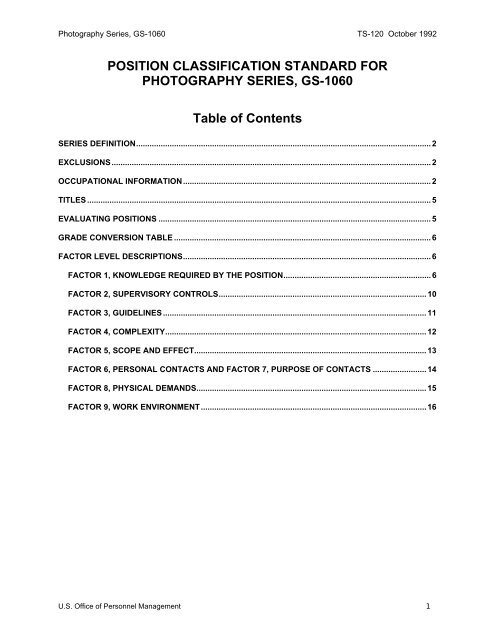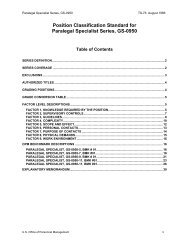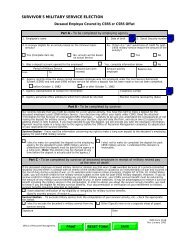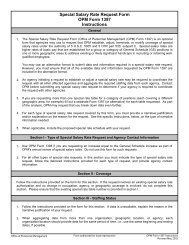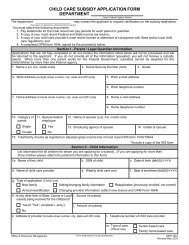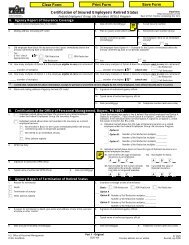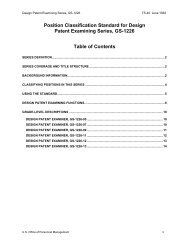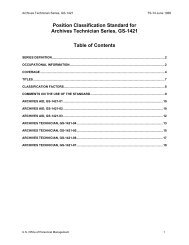Photography Series, GS-1060 - Office of Personnel Management
Photography Series, GS-1060 - Office of Personnel Management
Photography Series, GS-1060 - Office of Personnel Management
Create successful ePaper yourself
Turn your PDF publications into a flip-book with our unique Google optimized e-Paper software.
<strong>Photography</strong> <strong>Series</strong>, <strong>GS</strong>-<strong>1060</strong> TS-120 October 1992<br />
POSITION CLASSIFICATION STANDARD FOR<br />
PHOTOGRAPHY SERIES, <strong>GS</strong>-<strong>1060</strong><br />
Table <strong>of</strong> Contents<br />
SERIES DEFINITION.................................................................................................................................... 2<br />
EXCLUSIONS............................................................................................................................................... 2<br />
OCCUPATIONAL INFORMATION............................................................................................................... 2<br />
TITLES .......................................................................................................................................................... 5<br />
EVALUATING POSITIONS .......................................................................................................................... 5<br />
GRADE CONVERSION TABLE ................................................................................................................... 6<br />
FACTOR LEVEL DESCRIPTIONS............................................................................................................... 6<br />
FACTOR 1, KNOWLEDGE REQUIRED BY THE POSITION.................................................................. 6<br />
FACTOR 2, SUPERVISORY CONTROLS............................................................................................. 10<br />
FACTOR 3, GUIDELINES ...................................................................................................................... 11<br />
FACTOR 4, COMPLEXITY..................................................................................................................... 12<br />
FACTOR 5, SCOPE AND EFFECT........................................................................................................ 13<br />
FACTOR 6, PERSONAL CONTACTS AND FACTOR 7, PURPOSE OF CONTACTS ........................ 14<br />
FACTOR 8, PHYSICAL DEMANDS....................................................................................................... 15<br />
FACTOR 9, WORK ENVIRONMENT.....................................................................................................16<br />
U.S. <strong>Office</strong> <strong>of</strong> <strong>Personnel</strong> <strong>Management</strong> 1
<strong>Photography</strong> <strong>Series</strong>, <strong>GS</strong>-<strong>1060</strong> TS-120 October 1992<br />
SERIES DEFINITION<br />
This series includes positions that involve supervising or performing work in operating still,<br />
television (video), or motion picture cameras, and in processing photographic film and negatives.<br />
The work requires, in addition to a knowledge <strong>of</strong> the equipment, techniques, and processes <strong>of</strong><br />
photography, either (1) working knowledge <strong>of</strong> the subject matter to be photographed, and/or (2)<br />
artistic ability in selecting, arranging, and lighting subjects or in processing work.<br />
This standard supersedes the position classification standard for this series issued in October<br />
1963.<br />
EXCLUSIONS<br />
1. Classify in the Audiovisual Production <strong>Series</strong>, <strong>GS</strong>-1071, positions that involve directing<br />
the arrangements, sequences, actions, photography, sound, and editing for television or<br />
motion picture productions.<br />
2. Classify in the Visual Information <strong>Series</strong>, <strong>GS</strong>-1084, positions that involve planning and<br />
designing visual materials, such as photographs, illustrations, and diagrams, used in<br />
books, exhibits, videotapes, or other communications media.<br />
3. Classify in the most appropriate series under the Federal Wage System positions that<br />
involve using photographic equipment, processes, and techniques when the paramount<br />
requirements are skill and experience in a trade or craft. The positions do not require<br />
knowledge <strong>of</strong> the subject matter <strong>of</strong> the work involved or artistic ability in performing<br />
camera or processing work.<br />
4. Classify in the Photographic Technology <strong>Series</strong>, <strong>GS</strong>-1386, positions that involve<br />
performing research or other pr<strong>of</strong>essional and scientific work in the design, development,<br />
testing, and evaluation <strong>of</strong> photographic equipment and techniques.<br />
5. Classify in the Equipment Operator <strong>Series</strong>, <strong>GS</strong>-0350, positions that involve as the<br />
primary responsibility operating <strong>of</strong>fice micr<strong>of</strong>ilm, duplicating, and/or other <strong>of</strong>fice<br />
equipment.<br />
OCCUPATIONAL INFORMATION<br />
The photography occupation consists <strong>of</strong> two different but closely related functions: (1)<br />
capturing the image on film (camera work) and (2) developing the image so that it is visible to<br />
the viewer in the form <strong>of</strong> a slide, transparency, or print (processing work). Some photography<br />
positions involve both camera work and subsequent processing work.<br />
U.S. <strong>Office</strong> <strong>of</strong> <strong>Personnel</strong> <strong>Management</strong> 2
<strong>Photography</strong> <strong>Series</strong>, <strong>GS</strong>-<strong>1060</strong> TS-120 October 1992<br />
Camera Work<br />
Camera work requires familiarity with the camera equipment used in assignments to produce<br />
acceptable work. This may range from the standardized equipment that can be found in any<br />
commercial camera shop, such as 35 mm cameras and video camcorders, to more specialized<br />
equipment used primarily by pr<strong>of</strong>essional photographers, such as medium and large format<br />
cameras, studio-type television or motion picture cameras, and photoreproduction or "copy"<br />
cameras. The work may also involve use <strong>of</strong> equipment that has been adapted for highly<br />
specialized purposes, such as cameras mounted on microscopes or wired for remote control or<br />
automatic timed operation, or electronic equipment, such as computerized imaging. The<br />
essential knowledge is the same for film/chemical based photography work and<br />
computer/electronic aided photography work. The work also requires understanding the uses <strong>of</strong><br />
a wide range <strong>of</strong> special purpose accessories, including the many types <strong>of</strong> film, filters, diffusers,<br />
lenses, and lighting sources, such as fiber optics.<br />
All photography work concerns to some degree the elements <strong>of</strong> lighting and composition in the<br />
presentation <strong>of</strong> subjects, depending on the objectives <strong>of</strong> the photographs. Most photography<br />
work in the Federal service involves technical rather than artistic interpretation <strong>of</strong> the subject<br />
matter. The purpose <strong>of</strong> these photographs is to render a clear, realistic picture <strong>of</strong> certain items,<br />
features, or events, such as technical equipment, engineering tests, research subjects, medical<br />
specimens and procedures, art objects and museum artifacts, criminal evidence and crime scenes,<br />
or accident sites. <strong>Photography</strong> <strong>of</strong> this type is done primarily for training, documentation,<br />
identification, or study purposes, where lighting and composition are used to highlight or display<br />
the subjects in an effective, technically useful manner.<br />
Some photography work primarily concerns creating images that present subjects in an<br />
aesthetically pleasing or evocative manner. These photographs range from the "public affairs"<br />
pictures that appear in employee newsletters, to more sophisticated photographs taken for<br />
advertising purposes, for reproduction and sale, or for display in exhibits. In these photographs,<br />
lighting and composition are used creatively to attract viewer attention, create a favorable<br />
impression, or elicit certain emotional responses.<br />
Regardless <strong>of</strong> the purposes <strong>of</strong> the photographs, the difficulty inherent in camera work is largely a<br />
function <strong>of</strong> the planning involved and the amount <strong>of</strong> knowledge required about the subjects<br />
being photographed. In some cases, the photographer may control the content and composition<br />
<strong>of</strong> the photographs. The planning consists <strong>of</strong> selecting the subjects, background, positioning,<br />
and manner <strong>of</strong> presentation. In other cases, the subjects may consist <strong>of</strong> real-life events that<br />
cannot be altered by the photographer. Planning for these photographs involves studying the<br />
subjects in advance to anticipate the photographic opportunities or to identify those aspects that<br />
must be included in the photographic record. Generally speaking, the more planning that an<br />
assignment involves, the greater is the degree <strong>of</strong> knowledge or understanding <strong>of</strong> the subject<br />
required.<br />
Photographer (camera) positions at the lower grade levels tend to concentrate more on the<br />
application <strong>of</strong> the particular techniques required to take individual photographs. The degree <strong>of</strong><br />
subject matter knowledge required is usually limited to a familiarity with the common<br />
U.S. <strong>Office</strong> <strong>of</strong> <strong>Personnel</strong> <strong>Management</strong> 3
<strong>Photography</strong> <strong>Series</strong>, <strong>GS</strong>-<strong>1060</strong> TS-120 October 1992<br />
terminology <strong>of</strong> the program or discipline in order to understand instructions on what features <strong>of</strong><br />
the subjects to photograph. The planning is confined to assessing the particular equipment or<br />
lighting needed under the given environmental conditions.<br />
At the higher grade levels, photographers are more involved in taking sequences or collections <strong>of</strong><br />
photographs to document larger projects or activities. They must have a broader understanding<br />
<strong>of</strong> the objectives <strong>of</strong> the project, and knowledge <strong>of</strong> the operations or activities involved, in order<br />
to plan the photographic coverage in a way that will ensure accurate, comprehensive, and<br />
objective treatment <strong>of</strong> the subject. For example, a photographer <strong>of</strong> engineering tests has to<br />
understand the nature <strong>of</strong> the events to be captured to determine how the cameras should be set<br />
up, at what stages the photographic record should be made, whether the cameras may be<br />
damaged by the effects <strong>of</strong> the tests, and how to tie the camera controls into the whole process.<br />
As another example, a photographer taking a photographic record <strong>of</strong> a planned news event must<br />
be familiar with the background, the major participants and their interrelationships, and the<br />
individual activities expected in order to capture images that do not distort or misrepresent the<br />
actual occurrences.<br />
Processing Work<br />
Processing work requires familiarity with the range <strong>of</strong> equipment peculiar to individual<br />
assignments. This may range from the equipment common to most photographic processing<br />
laboratories, such as film and negative processors (both automated and manual), printers,<br />
enlargers, duplicators, filmstrip generators, contact printers, and vacuum frames, to more<br />
specialized equipment used for high precision or high resolution processing, such as manual and<br />
computerized rectifiers and orthophoto printers. It also includes the special purpose equipment<br />
used for repairing and duplicating motion picture film for archival preservation.<br />
Camera photography and processing photography generally require an equivalent degree <strong>of</strong><br />
technical knowledge <strong>of</strong> equipment and techniques. The processes used in developing and<br />
printing a piece <strong>of</strong> film are essentially similar to those used in recording the photograph, i.e., the<br />
exposure <strong>of</strong> the film to light. Either kind <strong>of</strong> photography requires understanding and applying<br />
the principles <strong>of</strong> lighting, color, and exposure and the uses and limitations <strong>of</strong> various films,<br />
filters, lenses, and papers. In fact, in many cases, a poorly shot piece <strong>of</strong> film can be salvaged<br />
through processing by altering the chemistry or exposure time or by extensive cropping or<br />
retouching. Likewise, processing work may require the same degree <strong>of</strong> subject matter<br />
knowledge as camera work. For example, processing a photograph designed to show the firing<br />
<strong>of</strong> a weapon involves understanding both the objectives <strong>of</strong> the test and the expected physical<br />
reactions to determine what specialized processing techniques will bring up or enhance the<br />
desired images.<br />
The difficulty inherent in processing positions is a function <strong>of</strong> the degree <strong>of</strong> precision or clarity<br />
required <strong>of</strong> the end products. At the lower extreme are those few work situations where the<br />
processing equipment is largely automated and requires minimal intervention on the part <strong>of</strong> the<br />
employee. (This type <strong>of</strong> situation is not addressed in this standard.) Most photographic<br />
assignments fall in the middle range, where the degree <strong>of</strong> clarity and resolution required is<br />
equivalent to what would be expected <strong>of</strong> a commercial film processing laboratory. In these<br />
U.S. <strong>Office</strong> <strong>of</strong> <strong>Personnel</strong> <strong>Management</strong> 4
<strong>Photography</strong> <strong>Series</strong>, <strong>GS</strong>-<strong>1060</strong> TS-120 October 1992<br />
cases, the employee may manipulate the colors and contrast to improve the quality <strong>of</strong> the images,<br />
but there is no requirement for a high degree <strong>of</strong> precision or sharpness <strong>of</strong> image. At the upper<br />
extreme are those assignments involving the application <strong>of</strong> intensive processing efforts to<br />
achieve a degree <strong>of</strong> quality and sharpness required for very specialized purposes. This is<br />
characteristic <strong>of</strong> photographs taken, for example, as identification for insurance purposes, as<br />
criminal evidence, or for cartographic use.<br />
TITLES<br />
Photographer is the title for nonsupervisory positions that involve primarily still photography or<br />
any form <strong>of</strong> film processing work.<br />
Videographer is the title for nonsupervisory positions that involve primarily operating video<br />
cameras.<br />
Supervisory Photographer and Supervisory Videographer are the titles for positions that meet the<br />
criteria in the appropriate supervisory grade evaluation guide.<br />
Agencies may add parenthetical titles <strong>of</strong> their choosing where further distinctions in the work are<br />
necessary for personnel management purposes.<br />
EVALUATING POSITIONS<br />
The grade level criteria in this standard cover typical full performance positions at grades <strong>GS</strong>-7<br />
through <strong>GS</strong>-11. When a position fails to meet the lowest, or exceeds the highest level provided<br />
for a particular factor, evaluate that factor using the FES Primary Standard along with this<br />
standard.<br />
Evaluate positions on a factor-by-factor basis using the factor level descriptions found in this<br />
standard. Only the designated point values may be used. This standard includes specific<br />
illustrative work situations to supplement the concepts contained in the factor level descriptions.<br />
Any one <strong>of</strong> these examples is not, by itself, totally representative <strong>of</strong> the factor level. Avoid<br />
evaluating positions solely on the basis <strong>of</strong> comparison with assignments covered in the<br />
illustrations. More complete instructions for evaluating positions under the Factor Evaluation<br />
System are found in the Introduction to the Position Classification Standards and The Classifier's<br />
Handbook<br />
U.S. <strong>Office</strong> <strong>of</strong> <strong>Personnel</strong> <strong>Management</strong> 5
<strong>Photography</strong> <strong>Series</strong>, <strong>GS</strong>-<strong>1060</strong> TS-120 October 1992<br />
GRADE CONVERSION TABLE<br />
Total points on all evaluation factors are converted to <strong>GS</strong> grade as follows:<br />
<strong>GS</strong> Grade<br />
Point Range<br />
7 1355-1600<br />
8 1605-1850<br />
9 1855-2100<br />
10 2105-2350<br />
11 2355-2750<br />
FACTOR LEVEL DESCRIPTIONS<br />
FACTOR 1, KNOWLEDGE REQUIRED BY THE POSITION<br />
Level 1-5 -- 750 Points<br />
In camera work, employees use knowledge <strong>of</strong> basic photographic composition in positioning<br />
subjects, arranging backgrounds, and selecting camera angles and views to achieve aesthetically<br />
pleasing results. They also use knowledge <strong>of</strong> the capabilities, limitations, compatibilities, and<br />
operation <strong>of</strong> a variety <strong>of</strong> standard and specialized cameras, including electronic still imaging, and<br />
accessories, including different films, filters, diffusers, lenses, and lights. Some employees<br />
apply basic knowledge <strong>of</strong> specialized subject matter terminology to understand instructions<br />
about what features <strong>of</strong> an object to photograph or emphasize. This knowledge is used in<br />
applying a range <strong>of</strong> complicated techniques to photograph different types <strong>of</strong> subjects under<br />
varying environmental conditions.<br />
OR<br />
In processing work, employees use knowledge <strong>of</strong> developing, copying, and printing processes<br />
and skill in operating a variety <strong>of</strong> manual and automatic photographic laboratory equipment to<br />
assess the condition <strong>of</strong> source materials, make requisite adjustments in processing methods, and<br />
apply processing and printing quality control procedures. They apply knowledge <strong>of</strong> the working<br />
characteristics <strong>of</strong> photographic chemicals and solutions, the effect <strong>of</strong> solution and air<br />
temperature on processing, and the interaction between a variety <strong>of</strong> chemicals and photographic<br />
films and papers. This knowledge is used in processing a range <strong>of</strong> photographic products that<br />
are tailored to achieve proper contrast, density, and color.<br />
U.S. <strong>Office</strong> <strong>of</strong> <strong>Personnel</strong> <strong>Management</strong> 6
<strong>Photography</strong> <strong>Series</strong>, <strong>GS</strong>-<strong>1060</strong> TS-120 October 1992<br />
Illustrations:<br />
- The employee provides photographic support to the organization's public information<br />
activities by photographing or videotaping award presentations, <strong>of</strong>ficial portraits,<br />
buildings and grounds, and staged or candid shots <strong>of</strong> equipment and work operations.<br />
The subjects <strong>of</strong> the photographs or videotapes are typically identified at the onset <strong>of</strong> the<br />
assignments. The employee applies knowledge <strong>of</strong> the appropriate cameras, lights, film<br />
type, lenses, and exposures needed to photograph indoors and outdoors, in confined and<br />
spacious areas, in natural and fluorescent lighting, and at night.<br />
- The employee photographs museum artifacts, equipment components, medical<br />
specimens, or other stationary objects for documentation, diagnostic, or training<br />
purposes. The assignments pose special technical problems related to the illumination <strong>of</strong><br />
small spaces, the reflective properties <strong>of</strong> the surfaces, or the need to show fine details or<br />
exact color renditions. The employee applies knowledge <strong>of</strong> how special lighting<br />
techniques, such as fiber optic, axial, or ring lighting, can be used to illuminate cavities<br />
or minute parts, and what special filters will eliminate glare and reflections, adjust colors,<br />
or enhance contrasts.<br />
- The employee develops black-and-white and color film; makes prints, photographic<br />
reproductions <strong>of</strong> drawings, charts, or printed material; and produces duplicate negatives,<br />
internegatives, slides, and viewgraphs. The employee evaluates the photographic<br />
characteristics <strong>of</strong> the source materials and selects corresponding films, filters, exposures,<br />
and papers based on their reproductive capabilities. The employee applies knowledge <strong>of</strong><br />
how the developing process can be manipulated (e.g., by changing chemical solutions,<br />
timing, exposure, or agitation) to compensate for deviations from normal film quality.<br />
The employee also applies skill in using techniques such as dodging, burning, cropping,<br />
and retouching to reduce obvious flaws in the material, and in applying sensitometric and<br />
densitometric tests to evaluate and adjust color balance and density.<br />
Level 1-6 -- 950 Points<br />
In camera work, employees use knowledge <strong>of</strong> the capabilities and limitations <strong>of</strong> specialized<br />
photographic equipment, films, and processes to adapt equipment to compensate for physical<br />
stresses and special wiring requirements. They also use knowledge <strong>of</strong> specialized photography<br />
requirements, such as high-speed cameras, special films, wired or photoelectric triggering<br />
mechanisms, or other specialized equipment or techniques to complete assignments requiring<br />
unusually high degrees <strong>of</strong> detail, critical timing, or critical focus. Some employees apply<br />
knowledge <strong>of</strong> the operations or characteristics <strong>of</strong> a specialized subject matter field, such as<br />
anatomy, forensic science, or a category <strong>of</strong> technical equipment, or <strong>of</strong> a program area or topic<br />
being depicted to plan the photographic coverage <strong>of</strong> subjects, events, or activities.<br />
Employees use knowledge <strong>of</strong> the organization, the photographic objectives, and viewer reaction<br />
to various types <strong>of</strong> images to select or stage scenes and events that will evoke the desired<br />
responses.<br />
U.S. <strong>Office</strong> <strong>of</strong> <strong>Personnel</strong> <strong>Management</strong> 7
<strong>Photography</strong> <strong>Series</strong>, <strong>GS</strong>-<strong>1060</strong> TS-120 October 1992<br />
In processing work, employees use knowledge <strong>of</strong> the physical and chemical properties <strong>of</strong><br />
unusual archival materials, such as glass plate negatives, nitrate film, diazo prints, and lantern<br />
slides, to generate photographic reproductions. This work also requires knowledge about<br />
compatibility with modern equipment and chemicals, and the specialized techniques used in<br />
handling them to repair and print from damaged, fragile, or deteriorated source media.<br />
OR<br />
Some employees use knowledge <strong>of</strong> and skill in operating special-purpose or high-precision<br />
photographic laboratory equipment to adapt standard procedures, techniques, and processes in<br />
processing film. They assess and resolve difficult or unusual problems related to the<br />
enhancement or correction <strong>of</strong> photographic images.<br />
Illustrations:<br />
- The employee performs still photographic and video documentation <strong>of</strong> surgeries, post<br />
mortems, and other medical procedures for research and education purposes. The<br />
employee coordinates with the surgical team prior to the procedure to determine<br />
photographic requirements and the equipment and lighting needed to capture the desired<br />
images. The employee uses subject-matter knowledge to anticipate the various stages in<br />
the procedure, to recognize points <strong>of</strong> interest, and to apply discretion in documenting<br />
elements beyond the scope <strong>of</strong> the surgeon's explicit instructions. This knowledge is also<br />
used in reviewing clinical case histories to document with photographs progression <strong>of</strong><br />
diseases or other medical phenomena over time.<br />
- The employee sets up and operates standard and high speed still and video cameras to<br />
document missile test launchings and flights, blast effects on launchers and targets, and<br />
pre-test missile installations. The employee meets with project engineers to review test<br />
plans and procedures and to determine the type <strong>of</strong> photographic information desired.<br />
Using knowledge <strong>of</strong> the capabilities and limitations <strong>of</strong> the photographic equipment used,<br />
the employee adapts the equipment to assure successful accomplishment <strong>of</strong> the test<br />
objectives and to withstand the stresses to which it will be subjected, such as rewiring<br />
power sources for remote control operation or building special mounts to withstand<br />
vibrations.<br />
- The employee performs studio and remote videography in support <strong>of</strong> the organization's<br />
audiovisual production facility. The employee reviews the script with the director prior<br />
to videotaping to define the production's photographic and stylistic requirements. The<br />
employee uses this understanding <strong>of</strong> the director's intentions to deviate from the script<br />
and take additional field shots that will facilitate editing, capture interesting scenes that<br />
were not anticipated, and minimize distracting audio and visual elements. The employee<br />
may also perform video documentation using his/her own initiative in determining what<br />
scenes are necessary to establish the main facts, accurately represent the event, and place<br />
it in proper context.<br />
U.S. <strong>Office</strong> <strong>of</strong> <strong>Personnel</strong> <strong>Management</strong> 8
<strong>Photography</strong> <strong>Series</strong>, <strong>GS</strong>-<strong>1060</strong> TS-120 October 1992<br />
The employee photographs criminal evidence and custom processes the film to obtain<br />
high quality photographs for investigative and legal purposes. The employee works<br />
closely with investigators to photograph latent fingerprints, such as perspiration, dust,<br />
and grease prints, and other evidence susceptible to photographic enhancement. The<br />
employee understands how images appear in the light spectrum and applies a range <strong>of</strong><br />
specialized technical methods to bring up fine details, sharpen images, or eliminate<br />
certain colors or features when processing photographic renditions that can be used in<br />
court.<br />
- The employee carries out precision processing operations to generate high quality,<br />
precisely scaled photographic reproductions <strong>of</strong> maps, charts, and other cartographic<br />
materials. The employee applies skill in the operation <strong>of</strong> a variety <strong>of</strong> specialized<br />
photographic laboratory equipment such as vacuum frames, precision process cameras,<br />
and manual rectifiers. The employee generates products with specified density, tone<br />
range, dimensional accuracy, and minimal distortion and image displacement.<br />
Level 1-7 -- 1250 Points<br />
Employees use a comprehensive knowledge <strong>of</strong> a wide range <strong>of</strong> specialized photographic<br />
equipment, techniques, and processes to develop, modify, or adapt equipment and procedures to<br />
meet new requirements or to perform assignments involving unusual or unprecedented situations<br />
that require photographic treatment. They use a knowledge <strong>of</strong> the most recent advancements in<br />
the field <strong>of</strong> photography and <strong>of</strong> the range <strong>of</strong> new equipment, experimental materials, techniques,<br />
or processes to create photographic products or to evaluate possibilities for improvements,<br />
modifications, or replacements <strong>of</strong> existing equipment, materials, and techniques. Some<br />
employees apply a thorough knowledge <strong>of</strong> the subject matter area including an understanding <strong>of</strong><br />
the objectives and operations involved in scientific, engineering, or medical research projects to<br />
independently plan the photographic recording and reporting.<br />
Some employees apply knowledge <strong>of</strong> the techniques and methods for communicating<br />
information with photography to create photographic products that go beyond being technically<br />
perfect to provide insight into the object itself or present a heightened aspect <strong>of</strong> reality. They<br />
also use this knowledge to create the illusion <strong>of</strong> real action, to simulate events, or to use trick<br />
photography in unprecedented situations where artistic and creative ability is required.<br />
Illustrations:<br />
- The employee participates as a member <strong>of</strong> the planning team in contributing<br />
photographic knowledge <strong>of</strong> the capabilities and limitations <strong>of</strong> cameras and equipment to<br />
the total planning <strong>of</strong> a medical, scientific, or engineering research project. The employee<br />
develops and adapts equipment and techniques that will be responsive to unusual or<br />
highly specialized situations requiring photographic treatment. Using a comprehensive<br />
knowledge <strong>of</strong> the subject matter and an understanding <strong>of</strong> the objectives <strong>of</strong> the research,<br />
the employee develops and designs the approach to the photographic aspects <strong>of</strong> the<br />
U.S. <strong>Office</strong> <strong>of</strong> <strong>Personnel</strong> <strong>Management</strong> 9
<strong>Photography</strong> <strong>Series</strong>, <strong>GS</strong>-<strong>1060</strong> TS-120 October 1992<br />
project. The employee determines what specific information will be presented to<br />
advance the informational or educational value <strong>of</strong> the photographic products.<br />
- The employee plans and produces photographs and videotapes including coverage <strong>of</strong> live<br />
and special events. The employee applies knowledge <strong>of</strong> new photographic equipment,<br />
methods, and procedures, trends in photography, and artistic and creative ability to<br />
present realistic photographic rendering <strong>of</strong> events or occurrences that, in fact, are not<br />
subject to successful "real life" photography. The employee uses special effects<br />
photography where a high degree <strong>of</strong> ingenuity and imagination is required and, where<br />
possible, exercises control over the setting or action <strong>of</strong> the event by "staging" actions to<br />
improve the artistic effect <strong>of</strong> the photographs.<br />
Level 2-3 -- 275 Points<br />
FACTOR 2, SUPERVISORY CONTROLS<br />
The supervisor makes assignments by defining objectives (e.g., indicating generally what<br />
features <strong>of</strong> the subjects should be emphasized or enhanced), priorities, and deadlines, and assists<br />
the employee when assignments call for substantial departures from established procedures or<br />
standard photographic techniques.<br />
The employee plans and carries out the successive steps <strong>of</strong> the photographic assignment and<br />
independently solves commonly occurring technical problems, such as inadequate lighting,<br />
poorly shot film, and equipment malfunctions.<br />
Completed work is evaluated for technical quality, appropriateness, and for meeting the<br />
objectives <strong>of</strong> the assignment. The methods used in accomplishing the work are not usually<br />
reviewed in detail.<br />
Level 2-4 -- 450 Points<br />
The employee is given only the overall objectives and resource limitations <strong>of</strong> the assignment,<br />
and participates with the supervisor or client in developing deadlines and the extent <strong>of</strong><br />
photographic coverage or resolution required.<br />
The employee, having developed expertise in the field, independently plans and carries out all<br />
phases <strong>of</strong> the assignment, resolves most differences that arise with clients, coordinates the work<br />
with others as necessary, and interprets policy on such matters as the photographing or<br />
presentation <strong>of</strong> given subjects.<br />
Completed work is reviewed only in terms <strong>of</strong> its effectiveness in meeting the objectives <strong>of</strong> the<br />
assignment.<br />
U.S. <strong>Office</strong> <strong>of</strong> <strong>Personnel</strong> <strong>Management</strong> 010
<strong>Photography</strong> <strong>Series</strong>, <strong>GS</strong>-<strong>1060</strong> TS-120 October 1992<br />
Level 3-2 -- 125 Points<br />
FACTOR 3, GUIDELINES<br />
The format and content <strong>of</strong> the visual product are specified and techniques and procedures for<br />
doing the work are established. Technical guides are available that provide detailed instructions<br />
on such matters as lens settings and exposure times to be used in taking routine photographs and<br />
in producing standard negatives and prints under normal conditions.<br />
The employee uses judgment in locating and selecting appropriate references and in making<br />
minor deviations in procedures to fit the specific assignment. Situations where precedents are<br />
not available or where procedures and methods must be substantially altered are referred to the<br />
supervisor for additional guidance.<br />
Level 3-3 -- 275 Points<br />
The parameters <strong>of</strong> the photographic assignment are well-defined in terms <strong>of</strong> the subject, the way<br />
in which it will be presented, and the aspects that are to be emphasized. However, methods for<br />
producing the work have not been specified in detail. Guidelines consist primarily <strong>of</strong><br />
photography manuals that address the accepted principles and techniques <strong>of</strong> still or video<br />
photography, processing, or duplication, but <strong>of</strong>ten do not cover the more specialized<br />
requirements <strong>of</strong> the work performed.<br />
The employee uses judgment in interpreting and adapting these guidelines for application to<br />
specific cases and problems. The employee is expected to recognize and exploit photographic<br />
opportunities that arise during the course <strong>of</strong> an assignment and to determine the specialized<br />
lighting and filters that will enhance the desired features.<br />
Level 3-4 -- 450 Points<br />
The work product expected is presented only in terms <strong>of</strong> a general theme to be expressed or an<br />
objective to be achieved. The content and style <strong>of</strong> the photographs or the equipment<br />
configurations used are left largely to the discretion <strong>of</strong> the employee. Because <strong>of</strong> the unique<br />
nature <strong>of</strong> the projects, guidelines are scarce or <strong>of</strong> limited use. Those guidelines that do exist<br />
consist primarily <strong>of</strong> photography textbooks that discuss the aesthetic aspects <strong>of</strong> composition,<br />
lighting, and style, or the operating features and capabilities <strong>of</strong> standard and specialized<br />
photographic equipment.<br />
The employee uses initiative and resourcefulness in evaluating the subjects to be photographed,<br />
identifying the visual elements necessary to represent the topic or event accurately, and devising<br />
new ways to present the subjects or capture the images desired. In some work situations, the<br />
employee may test and evaluate complex, experimental materials or processes by using precision<br />
photographic analysis equipment to analyze their chemical, physical, and optical properties, or<br />
make significant adaptations to existing equipment to meet specialized requirements.<br />
U.S. <strong>Office</strong> <strong>of</strong> <strong>Personnel</strong> <strong>Management</strong> 11
<strong>Photography</strong> <strong>Series</strong>, <strong>GS</strong>-<strong>1060</strong> TS-120 October 1992<br />
Level 4-3 -- 150 Points<br />
FACTOR 4, COMPLEXITY<br />
The work involves a variety <strong>of</strong> photographic assignments, each with its own technical<br />
requirements and processes.<br />
- In camera work, the assignments typically involve a variety <strong>of</strong> still and limited video<br />
photography. The subjects to be photographed are specified, the extent <strong>of</strong> coverage is<br />
predetermined, and the general format is established. The emphasis is on taking clear<br />
photographs to document visually objects, images, or events, or to display certain<br />
features. The employee's discretion on the photographic composition is generally limited<br />
to determining the position, background, lighting, angles, distance, and other aspects that<br />
will complement or enhance the subjects. However, the assignments require the use <strong>of</strong><br />
different cameras, lenses, lens settings, film, filters, lighting equipment, and other<br />
accessories to produce images <strong>of</strong> acceptable quality.<br />
- In processing work, the assignments involve producing a variety <strong>of</strong> standard<br />
photographic products such as color or black-and-white prints, enlargements, slides,<br />
contact prints, and duplicate negatives. The work is done both using automated<br />
equipment and manually for "custom" jobs. The emphasis is on maintaining consistent<br />
levels <strong>of</strong> quality and on applying corrective measures to compensate for defects in the<br />
source materials. The employee uses discretion in identifying what aspects <strong>of</strong> the image<br />
can be manipulated to enhance the quality <strong>of</strong> the end product such as adjusting density,<br />
correcting color balance, controlling contrast, or minimizing shadows or glare.<br />
The employee makes decisions on the technical processes that will be used to assure the optimal<br />
photographic product. These decisions are based on such considerations as the amount <strong>of</strong> light<br />
available, the properties and characteristics <strong>of</strong> the subjects, the degree <strong>of</strong> detail required, or, in<br />
processing work, the type and condition <strong>of</strong> the film or negatives and the nature <strong>of</strong> the end<br />
product desired.<br />
The employee identifies features that are difficult to photograph, such as reflective surfaces, fine<br />
or subsurface details, confined spaces, or moving parts, or that pose processing problems, such<br />
as under or over exposed film. The employee makes compensating adjustments in equipment<br />
and techniques.<br />
Level 4-4 -- 225 Points<br />
The work involves varied photographic assignments requiring the application <strong>of</strong> a wide range <strong>of</strong><br />
processes, methods, and techniques.<br />
- In camera work, the subjects are identified but no specific format, composition, or<br />
manner <strong>of</strong> presentation have been specified in advance. The emphasis is on working with<br />
the client in planning the content and execution <strong>of</strong> a photographic collection. In some<br />
U.S. <strong>Office</strong> <strong>of</strong> <strong>Personnel</strong> <strong>Management</strong> 212
<strong>Photography</strong> <strong>Series</strong>, <strong>GS</strong>-<strong>1060</strong> TS-120 October 1992<br />
cases, these products may be designed to document or encapsulate large-scale activities<br />
or a complex sequence <strong>of</strong> events, for example, the photographic coverage <strong>of</strong> a political<br />
convention, the construction <strong>of</strong> a building, the stages <strong>of</strong> a scientific research program, the<br />
growth <strong>of</strong> a bacterial culture, a surgical procedure, or a pathological specimen. In others,<br />
they may be designed to achieve certain unusual visual effects, for example, creating the<br />
illusion <strong>of</strong> reality through the use <strong>of</strong> miniature sets and special lighting.<br />
- In processing work, the assignments involve photographic products that must meet highly<br />
specialized requirements and standards <strong>of</strong> quality or precision. The emphasis is on<br />
working with very poor quality, damaged, fragile, or otherwise inadequate source<br />
materials to produce prints that will meet the requirements <strong>of</strong> the users. The actual<br />
camera work that was done in recording the image is <strong>of</strong>ten subordinate to the processing<br />
work in the development <strong>of</strong> the end product. For example, the photographs may have<br />
been taken by amateurs or by automated equipment, with the processors then responsible<br />
for recovering the maximum information from this imagery to achieve the degree <strong>of</strong><br />
clarity or precision required.<br />
The employee makes decisions on the composition <strong>of</strong> the final photographic products by<br />
identifying the important features <strong>of</strong> the subject in relation to the purposes <strong>of</strong> the photographs.<br />
In camera work, the employee assesses how these features can best be displayed or represented<br />
in a manner that ensures comprehensive, accurate, and objective portrayal <strong>of</strong> the subject. The<br />
employee also decides the scenes, angles, and views that will be photographed and, if necessary,<br />
the models or materials that will be needed to stage elements <strong>of</strong> the photographs. In processing<br />
work, the employee assesses how the source material can be manipulated, through the selective<br />
use <strong>of</strong> filters, exposures, and other techniques, to accentuate the main points <strong>of</strong> interest.<br />
The assignments typically involve complicating conditions that require modifying standard<br />
photographic methods and techniques or adapting equipment to meet specialized requirements.<br />
In camera work, these may include taking photographs under extreme or difficult environmental<br />
conditions, such as in heavy rain or wind, under water, or through glass, or compensating for<br />
limitations and incompatibilities in photographic materials and equipment, such as by<br />
manipulating filtration and lighting to achieve precise color renditions. In processing work,<br />
assignments may include handling source materials with multiple deficiencies that require<br />
different treatments such as negatives that are faded and stained in different areas.<br />
Level 5-2 -- 75 Points<br />
FACTOR 5, SCOPE AND EFFECT<br />
The purpose <strong>of</strong> the work is to produce photographic products that require application <strong>of</strong><br />
fundamental methods, techniques, and procedures in the use <strong>of</strong> standard camera equipment.<br />
The work products affect the accuracy <strong>of</strong> information to convey clearly and simply the required<br />
meaning.<br />
U.S. <strong>Office</strong> <strong>of</strong> <strong>Personnel</strong> <strong>Management</strong> 313
<strong>Photography</strong> <strong>Series</strong>, <strong>GS</strong>-<strong>1060</strong> TS-120 October 1992<br />
Level 5-3 -- 150 Points<br />
The purpose <strong>of</strong> the work is to produce a variety <strong>of</strong> conventional photographic products that<br />
depict subject matter information or events. These products are conventional in that they are<br />
executed using well-established processes and specifications or the same general manner <strong>of</strong><br />
presentation as other precedent materials.<br />
The work products affect the adequacy <strong>of</strong> the organization’s local training, public information,<br />
or scientific documentation activities.<br />
Level 5-4 -- 225 Points<br />
The purpose <strong>of</strong> the work is to plan the composition, coverage, and execution <strong>of</strong> a photographic<br />
collection or to perform high-precision photographic processing. The work typically involves a<br />
number <strong>of</strong> unusual technical problems, such as photographing subjects under extreme<br />
environmental conditions or by remote control, devising ways to express abstract ideas through<br />
photography, or processing old photographic materials that are incompatible with modern<br />
developing chemicals and equipment.<br />
The work affects a wide range <strong>of</strong> agency activities such as public information efforts covering<br />
the programs and operations <strong>of</strong> a major organization and its subordinate field units, the activities<br />
<strong>of</strong> other agencies involved in related work, or major activities <strong>of</strong> commercial photography<br />
laboratories.<br />
FACTOR 6, PERSONAL CONTACTS AND FACTOR 7, PURPOSE OF<br />
CONTACTS<br />
Match the level <strong>of</strong> regular and recurring personal contacts with the directly related purpose <strong>of</strong><br />
contacts and credit the appropriate point value using the chart below.<br />
Persons Contacted<br />
1. Contacts are with employees in the immediate <strong>of</strong>fice and in related support <strong>of</strong>fices.<br />
2. Contacts are with employees in different functions or program areas or at various<br />
organizational levels in the same agency but outside the photography organization.<br />
These contacts are generally for established and routine relationships. Contacts include<br />
illustrating and printing personnel, editors, commercial photography laboratories, and<br />
specialists and technicians in other fields.<br />
3. Contacts are with individuals or groups from outside the agency on matters for which<br />
there is no routine working relationship already established. Contacts include<br />
representatives <strong>of</strong> manufacturers <strong>of</strong> photographic equipment and materials, publication<br />
editors, and contractors.<br />
U.S. <strong>Office</strong> <strong>of</strong> <strong>Personnel</strong> <strong>Management</strong> 414
<strong>Photography</strong> <strong>Series</strong>, <strong>GS</strong>-<strong>1060</strong> TS-120 October 1992<br />
Purpose <strong>of</strong> Contacts<br />
a. Contacts are to obtain or request information needed to produce photographic products.<br />
b. Contacts are to plan, coordinate, or advise on work efforts or to resolve technical<br />
problems by influencing individuals or groups who are working toward mutual goals and<br />
are basically cooperative. Contacts may involve planning, advising, and resolving<br />
photographic work efforts in regard to research or informational programs.<br />
C<br />
O<br />
N<br />
T<br />
A<br />
C<br />
T<br />
S<br />
P U R P O S E<br />
a<br />
b<br />
1 30* 60<br />
2 45 75<br />
3 80 110<br />
*This combination is unlikely.<br />
FACTOR 8, PHYSICAL DEMANDS<br />
Level 8-1 -- 5 Points<br />
The work is primarily sedentary, although there is some walking, traveling, and carrying <strong>of</strong><br />
lightweight equipment and materials.<br />
Level 8-2 -- 20 Points<br />
The work requires some physical exertion such as long periods <strong>of</strong> standing; walking over rough<br />
or rocky surfaces; recurring bending, crouching, or stretching; and recurring lifting <strong>of</strong><br />
moderately heavy equipment and materials.<br />
Level 8-3 -- 50 Points<br />
The work requires considerable and strenuous physical exertion such as frequent climbing <strong>of</strong> tall<br />
ladders, lifting heavy objects over 22.5 kilograms (50 lbs), and crouching or crawling in<br />
restricted areas.<br />
U.S. <strong>Office</strong> <strong>of</strong> <strong>Personnel</strong> <strong>Management</strong> 515
<strong>Photography</strong> <strong>Series</strong>, <strong>GS</strong>-<strong>1060</strong> TS-120 October 1992<br />
Level 9-1 -- 5 Points<br />
FACTOR 9, WORK ENVIRONMENT<br />
The work is typically performed in adequately lighted and climate controlled <strong>of</strong>fices and studios<br />
and requires no special safety precautions.<br />
Level 9-2 -- 20 Points<br />
The work requires moderate risks or discomforts such as working near or on moving machinery,<br />
using flammable or explosive materials, or being exposed to irritant chemicals or infectious<br />
diseases. The work may require special safety precautions and the use <strong>of</strong> protective clothing or<br />
gear.<br />
U.S. <strong>Office</strong> <strong>of</strong> <strong>Personnel</strong> <strong>Management</strong> 616


